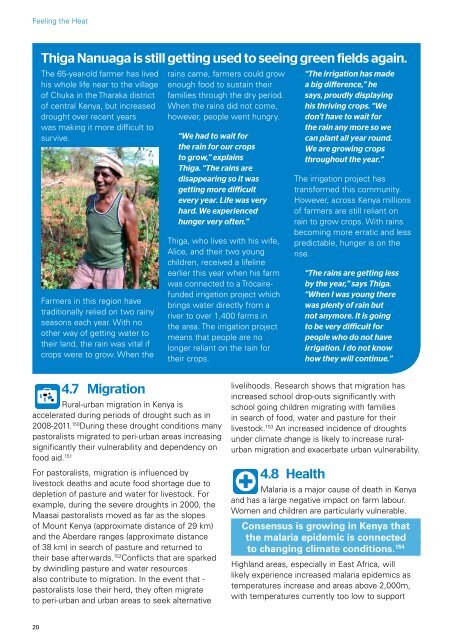trocaire-climate-change-report-2014
trocaire-climate-change-report-2014
trocaire-climate-change-report-2014
Create successful ePaper yourself
Turn your PDF publications into a flip-book with our unique Google optimized e-Paper software.
Feeling the Heat<br />
Thiga Nanuaga is still getting used to seeing green fields again.<br />
The 65-year-old farmer has lived<br />
his whole life near to the village<br />
of Chuka in the Tharaka district<br />
of central Kenya, but increased<br />
drought over recent years<br />
was making it more difficult to<br />
survive.<br />
Farmers in this region have<br />
traditionally relied on two rainy<br />
seasons each year. With no<br />
other way of getting water to<br />
their land, the rain was vital if<br />
crops were to grow. When the<br />
rains came, farmers could grow<br />
enough food to sustain their<br />
families through the dry period.<br />
When the rains did not come,<br />
however, people went hungry.<br />
“We had to wait for<br />
the rain for our crops<br />
to grow,” explains<br />
Thiga. “The rains are<br />
disappearing so it was<br />
getting more difficult<br />
every year. Life was very<br />
hard. We experienced<br />
hunger very often.”<br />
Thiga, who lives with his wife,<br />
Alice, and their two young<br />
children, received a lifeline<br />
earlier this year when his farm<br />
was connected to a Trócairefunded<br />
irrigation project which<br />
brings water directly from a<br />
river to over 1,400 farms in<br />
the area. The irrigation project<br />
means that people are no<br />
longer reliant on the rain for<br />
their crops.<br />
“The irrigation has made<br />
a big difference,” he<br />
says, proudly displaying<br />
his thriving crops. “We<br />
don’t have to wait for<br />
the rain any more so we<br />
can plant all year round.<br />
We are growing crops<br />
throughout the year.”<br />
The irrigation project has<br />
transformed this community.<br />
However, across Kenya millions<br />
of farmers are still reliant on<br />
rain to grow crops. With rains<br />
becoming more erratic and less<br />
predictable, hunger is on the<br />
rise.<br />
“The rains are getting less<br />
by the year,” says Thiga.<br />
“When I was young there<br />
was plenty of rain but<br />
not anymore. It is going<br />
to be very difficult for<br />
people who do not have<br />
irrigation. I do not know<br />
how they will continue.”<br />
4.7 Migration<br />
Rural-urban migration in Kenya is<br />
accelerated during periods of drought such as in<br />
2008-2011. 150 During these drought conditions many<br />
pastoralists migrated to peri-urban areas increasing<br />
significantly their vulnerability and dependency on<br />
food aid. 151<br />
For pastoralists, migration is influenced by<br />
livestock deaths and acute food shortage due to<br />
depletion of pasture and water for livestock. For<br />
example, during the severe droughts in 2000, the<br />
Maasai pastoralists moved as far as the slopes<br />
of Mount Kenya (approximate distance of 29 km)<br />
and the Aberdare ranges (approximate distance<br />
of 38 km) in search of pasture and returned to<br />
their base afterwards. 152 Conflicts that are sparked<br />
by dwindling pasture and water resources<br />
also contribute to migration. In the event that -<br />
pastoralists lose their herd, they often migrate<br />
to peri-urban and urban areas to seek alternative<br />
livelihoods. Research shows that migration has<br />
increased school drop-outs significantly with<br />
school going children migrating with families<br />
in search of food, water and pasture for their<br />
livestock. 153 An increased incidence of droughts<br />
under <strong>climate</strong> <strong>change</strong> is likely to increase ruralurban<br />
migration and exacerbate urban vulnerability.<br />
4.8 Health<br />
Malaria is a major cause of death in Kenya<br />
and has a large negative impact on farm labour.<br />
Women and children are particularly vulnerable.<br />
Consensus is growing in Kenya that<br />
the malaria epidemic is connected<br />
to changing <strong>climate</strong> conditions. 154<br />
Highland areas, especially in East Africa, will<br />
likely experience increased malaria epidemics as<br />
temperatures increase and areas above 2,000m,<br />
with temperatures currently too low to support<br />
20


